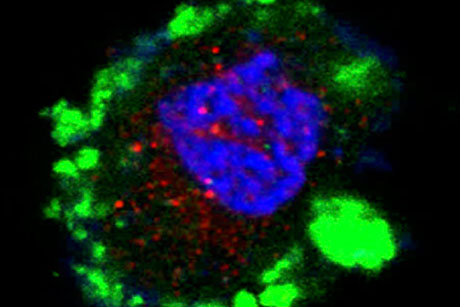Probiotic treats diabetes in rats, could lead to human remedy
January 29, 2015

This image shows a rat intestinal epithelial cell reprogrammed to express insulin (green). The cell nucleus is stained blue. (Credit: Franklin F. Duan et al./Diabetes)
Imagine a pill that helps people control diabetes with the body’s own insulin to lower blood glucose levels.
Cornell researchers have achieved this feat in rats by engineering human lactobacilli, a common gut bacteria, to secrete a protein that modifies intestinal cells to produce insulin.
A 2003 study led by Atsushi Suzuki of the University of Tsukuba, Japan, first demonstrated that when exposed to a protein called Glucagon-like peptide 1 (GLP-1), intestinal epithelial cells (which cover the guts) are converted into insulin-producing cells.
But until now, it has not been possible to administer GLP-1 into a live animal without injecting it — a method of administration that is not very effective.
Bypassing injections with a probiotic
The researchers came up a clever way to secrete GLP-1 in the gut without injecting it:
1. They engineered a strain of lactobacillus, a human probiotic (“good bacteria”), to secrete GLP-1.
2. They administered the modified probiotic bacteria orally to diabetic rats for 90 days.
3. Upper intestinal epithelial cells in diabetic rats were converted into cells that acted very much like pancreatic cells (cells that monitor blood glucose levels and secrete insulin as needed to balance glucose levels in healthy individuals).
4. Rats with high blood glucose (called hyperglycemia, a hallmark of diabetes) that received the engineered probiotic ended up with up to 30 percent lower blood glucose levels.
A pill instead of an injection
The rat study was a proof of principle; future work will test higher doses to see if a complete treatment can be achieved, said John March, professor of biological and environmental engineering in the College of Agriculture and Life Sciences and the paper’s senior author.
The technology is being licensed by the company BioPancreate, which is working to get the therapy into production for human use. Human patients would likely take a pill each morning to help control their diabetes, March said.
The study, published Jan. 27 in the journal Diabetes, is funded by the National Institutes of Health and the Hartwell Foundation.
Abstract for Engineered commensal bacteria reprogram intestinal cells into glucose-responsive insulin-secreting cells for the treatment of diabetes
The inactive full-length form of GLP-1(1–37) stimulates conversion of both rat and human intestinal epithelial cells into insulin-secreting cells. We investigated whether oral administration of human commensal bacteria engineered to secrete GLP-1(1–37) could ameliorate hyperglycemia in a rat model of diabetes by reprogramming intestinal cells into glucose-responsive insulin-secreting cells. Diabetic rats were fed daily with human lactobacilli engineered to secrete GLP-1(1–37). Diabetic rats fed GLP-1-secreting bacteria showed significant increases in insulin levels and, additionally, were significantly more glucose tolerant than those fed the parent bacterial strain. These rats developed insulin-producing cells within the upper intestine in numbers sufficient to replace ∼25–33% of the insulin capacity of nondiabetic healthy rats. Intestinal tissues in rats with reprogrammed cells expressed MafA, PDX-1, and FoxA2. HNF-6 expression was observed only in crypt epithelia expressing insulin and not in epithelia located higher on the villous axis. Staining for other cell markers in rats treated with GLP-1(1–37)-secreting bacteria suggested that normal function was not inhibited by the close physical proximity of reprogrammed cells. These results provide evidence of the potential for a safe and effective nonabsorbed oral treatment for diabetes and support the concept of engineered commensal bacterial signaling to mediate enteric cell function in vivo.